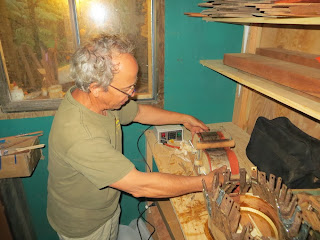Last October we went up to Sendai on our way to Yamagata and attended a lecture about the early history of traditional kokeshis by Mr. Takahashi Goro 高橋五郎さん, a long-time kokeshi historian who wrote the 1983 book 仙台周辺のこけし:その源流 を探る
Kokeshis of the Sendai Area: A Search for Their Origins. Obviously, then, Mr. Takahashi has been working for decades to discover the true origins of this marvelous folk-craft. His task has been easier said than done though, as kokeshis evolved naturally as toys in the 19th century in the Tohoku region and weren't "discovered" as a legitimate folk art until the early 20th century. Nevertheless, through Mr. Takahashi's research, along with that of various kokeshi associations and generations of work by individual researchers, a genealogy is coming into focus. While I am not ready to explain Mr. Takahashi's precise findings in this blog, suffice it to say that his research brought him to Yamagata Prefecture and Naruko Onsen for some of the earliest kokeshis as we know them today.
 |
| Mr. Takahashi's talk was introduced by Mr. Kamei, who owns the building that is home to the Kamei Museum. I chatted with Mr. Kamei for a few minutes afterwards and his two loves are kokeshis and butterflies, both of which are on display in the museum. |
 |
| Mr. Takahashi holding up a really old kokeshi that he discovered a few years ago in Yamagata Prefecture. It's a real treasure. |
 |
| Old kokeshis |
A large crowd of kokeshi enthusiasts from Tokyo, Sendai, and elsewhere gathered at the Kamei Museum to hear Mr. Takahashi's lecture and see some authentically old kokeshis. While they are definitely antiques, their true value comes from their historical significance. The lecture was very well received, and everyone was quite interested to take a close look at and hold the old kokeshis.
 |
| Hands on time with the old kokeshis. I guess at this point it doesn't matter if people touch them with their bare hands. |
 |
| Naoko chatting with Mr. Takahashi after the lecture. |
Besides the book mentioned above, since 2012 Mr. Takahashi has been writing a series of history articles for the Sendai newspaper
Kahoku Shinpo. They're of course in Japanese, but even if one doesn't read Japanese they're worth taking a look at on his web site
here.
 |
The Kahoku Shinpo newspaper building near the Kamei Museum. For those who don't know that's a map of Tohoku, the kokeshi homeland.
 |
| The first of Mr. Takahashi's recurring kokeshi history articles from the Kahoku Shinpo. |
|
This was really a great event, maybe even an adventure, and it shows the level of research and interest that some of our fellow kokeshi enthusiasts are doing. While Naoko and I are not quite yet involved with this level of research about kokeshis, we're very happy to see that the history is being written.






















































